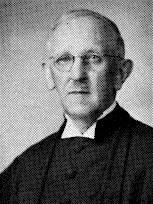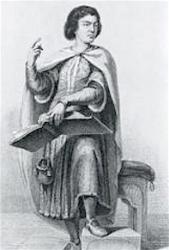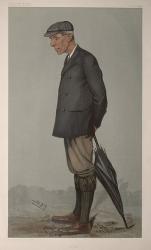Planning worship?
Check out our sister site, ZeteoSearch.org,
for 20+ additional resources related to your search.
- |
User Links
Person Results
‹ Return to hymnal




Export as CSV
J. C. Aaberg

1877 - 1970 Person Name: Jens C. Aaberg Hymnal Number: 219 Translator of "Bright and glorious is the sky" in Hymnal Jens Christian Aaberg (b. Moberg, Denmark, 1877; d. Minneapolis, MN, 1970) immigrated to the United States in 1901. Educated at Grand View College and Seminary in Des Moines, Iowa, he entered the ministry of the Danish Evangelical Lutheran Church in America and served congregations in Marinette, Wisconsin; Dwight, Illinois; and Minneapolis, Minnesota. Aaberg wrote Hymns and Hymnwriters of Denmark (1945), translated at least eighty hymns from Danish into English, and served on four hymnal committees. In 1947 King Frederick of Denmark awarded him the Knight Cross of Denmark.
--Psalter Hymnal Handbook, 1987
J. C. Aaberg
Asahel Abbott
1805 - 1899 Person Name: Asahel Abbot Hymnal Number: 91 Composer of "PRAYER" in Hymnal
Asahel Abbott
Peter Abelard

1079 - 1142 Person Name: Peter Abelard, 12th c. Hymnal Number: 244 Author of "Alone thou goest forth" in Hymnal Abelard, Peter, born at Pailais, in Brittany, 1079. Designed for the military profession, he followed those of philosophy and theology. His life was one of strange chances and changes, brought about mainly through his love for Heloise, the niece of one Fulbert, a Canon of the Cathedral of Paris, and by his rationalistic views. Although a priest, he married Heloise privately. He was condemned for heresy by the Council of Soissons, 1121, and again by that of Sens, 1140; died at St. Marcel, near Chalons-sur-Saône, April 21, 1142. For a long time, although his poetry had been referred to both by himself and by Heloise, little of any moment was known except the Advent hymn, Mittit ad Virginem, (q.v.). In 1838 Greith published in his Spicihgium Vaticanum, pp. 123-131, six poems which had been discovered in the Vatican. Later on, ninety-seven hymns were found in the Royal Library at Brussels, and pub. in the complete edition of Abelard's works, by Cousin, Petri Abelardi Opp., Paris, 1849. In that work is one of his best-known hymns, Tuba Domini, Paule, maxima (q.v.). Trench in his Sacra Latina Poetry, 1864, gives his Ornarunt terram germina (one of a series of poems on the successive days' work of the Creation), from Du Meril's Poesies Popul. Lat. du Moyen Age, 1847, p. 444.
-John Julian, Dictionary of Hymnology (1907)
Peter Abelard
Joseph Addison

1672 - 1719 Hymnal Number: 72 Author of "When all thy mercies, O my God" in Hymnal Addison, Joseph, born at Milston, near Amesbury, Wiltshire, May 1, 1672, was the son of the Rev. Lancelot Addison, sometime Dean of Lichfield, and author of Devotional Poems, &c, 1699. Addison was educated at the Charterhouse, and at Magdalen College, Oxford, graduating B.A. 1691 and M.A. 1693. Although intended for the Church, he gave himself to the study of law and politics, and soon attained, through powerful influence, to some important posts. He was successively a Commissioner of Appeals, an Under Secretary of State, Secretary to the Lord Lieutenant of Ireland, and Chief Secretary for Ireland. He married, in 1716, the Dowager Countess of Warwick, and died at Holland House, Kensington, June 17, 1719. Addison is most widely known through his contributions to The Spectator, The Toiler, The Guardian, and The Freeholder. To the first of these he contributed his hymns. His Cato, a tragedy, is well known and highly esteemed. Addison's claims to the authorship of the hymns usually ascribed to him, or to certain of them, have been called in question on two occasions. The first was the publication, by Captain Thompson, of certain of those hymns in his edition of the Works of Andrew Marvell, 1776, as the undoubted compositions of Marvell; and the second, a claim in the Athenaeum, July 10th, 1880, on behalf of the Rev. Richard Richmond. Fully to elucidate the subject it will be necessary, therefore, to give a chronological history of the hymns as they appeared in the Spectator from time to time.
i. The History of the Hymns in The Spectator. This, as furnished in successive numbers of the Spectator is :—
1. The first of these hymns appeared in the Spectator of Saturday, July 26, 1712, No. 441, in 4 stanzas of 6 lines. The article in which it appeared was on Divine Providence, signed “C." The hymn itself, "The Lord my pasture shall prepare," was introduced with these words:—
"David has very beautifully represented this steady reliance on God Almighty in his twenty-third psalm, which is a kind of pastoral hymn, and filled with those allusions which are usual in that kind of writing As the poetry is very exquisite, I shall present my readers with the following translation of it." (Orig. Broadsheet, Brit. Mus.)
2. The second hymn appeared in the Spectator on Saturday, Aug. 9, 1712, No. 453, in 13 st. of 4 1., and forms the conclusion of an essay on " Gratitude." It is also signed " C," and is thus introduced:—
“I have already obliged the public with some pieces of divine poetry which have fallen into my hands, and as they have met with the reception which they deserve, I shall, from time to time, communicate any work of the same nature which has not appeared in print, and may be acceptable to my readers." (Orig. Broadsheet, British Museum)
Then follows the hymn:—"When all Thy mercies, 0 my God."
3. The number of the Spectator for Tuesday, Aug. 19, 1712, No. 461, is composed of three parts. The first is an introductory paragraph by Addison, the second, an unsigned letter from Isaac Watts, together with a rendering by him of Ps. 114th; and the third, a letter from Steele. It is with the first two we have to deal. The opening paragraph by Addison is:—
“For want of time to substitute something else in the Boom of them, I am at present obliged to publish Compliments above my Desert in the following Letters. It is no small Satisfaction, to have given Occasion to ingenious Men to employ their Thoughts upon sacred Subjects from the Approbation of such Pieces of Poetry as they have seen in my Saturday's papers. I shall never publish Verse on that Day but what is written by the same Hand; yet shall I not accompany those Writings with Eulogiums, but leave them to speak for themselves." (Orig. Broadsheet, British Museum
Joseph Addison
Biodun Adebesin
b. 1928 Person Name: Biodum Adebesin Hymnal Number: 10 Translator of "Jesus, we want to meet" in Hymnal Adebesin, Biodun Akinremi Olvsoji. (Lagos, Nigeria, January 1, 1928-- ). He began playing piano at the age of nine and continued studying music in school and college. He earned a certificate from Cambridge and was an associate of the Royal College of Music. He performed in jazz, theater, and club bands and orchestras. Adebesin was a teacher, banker, civil servant, and a member of the Nigerian diplomatic service. He authored Okanlawon and Ale Wa Adara and translated "Jesus, we want to meet."
--Carlton R. Young, DNAH Archives
Biodun Adebesin
Johann Rudolf Ahle
1625 - 1673 Person Name: Johann R. Ahle Hymnal Number: 13 Composer of "LIEBSTER JESU, WIR SIND HIER" in Hymnal Johann Rudolph Ahle, b. Mühlhausen, 1625; Ahle studied theology at Erfurt University. Little is known about his musical education, but be became well known as an organist while he was in Erfurt. He returned to Mühlhausen and became an organist at St. Blasius Church, he composed organ music but is know for his sacred choral music. He was the father of Johann Georg, who was also a composer and succeeded his father as organist at St. Blasius Church. Johann Rudolf became mayor of Mühlhausen late in his life and died there in 1673.
Dianne Shapiro (from Bach Cantatas Website www.bach-cantatas.com/Lib/Ahle-Johann-Rudolf.htm)
Johann Rudolf Ahle
Arthur Campbell Ainger

1841 - 1919 Person Name: Arthur C. Ainger Hymnal Number: 638 Author of "God is working his purpose out" in Hymnal Ainger, Arthur Campbell, M.A., son of the Rev. F. A. Ainger, incumbent of Hampstead, Middlesex; born in 1841, educated Trinity College, Cambridge, 1st Class Class. Trip. 1864, Assistant Master at Eton 1864-1901. Author of Eton Songs, 1901-2; Carmen Etonense, Vale, &c, and joint author with H. G. Winkle, M.A., of an English-Latin Verse Dictionary. Mr. Ainger's hymns in common use are the following :—
1. God is working His purpose out. [Missions.] Written and first published in 1894, with Dedication to Archbishop Benson. It was given in Church Hymns, 1903, Hymns Ancient & Modern, 1904, and other collections.
2. God of our Fathers, unto Thee. [National Thanksgiving.] Included in English Hymnal, 1906.
3. Let all our brethren join in one. [Harvest.] Included in C. W. A. Brooke's Additional Hymns, 1903.
4. Let God arise to lead forth those. [In Time of War.] Written in 1900, and first printed in the Times the same year. Subsequently pub. by Novello & Co., with music by Sir J. Stainer, and included in Church Hymns, 1903, and Hymns Ancient & Modern, 1904.
5. Like a mighty man rejoicing in his strength. [Missions.] Written by request for the S.P.G. Centenary, and published in the Centenary collection of Hymns, 1901.
6. Not ours to mourn and weep. [Lent. For the Young.] First published in the Public School Hymn Book, 1903.
7. On them who here, 0 Lord. [Holy Matrimony.] A Wedding Hymn, published with music by Novello & Co., 1903. A most acceptable addition to hymns for Holy Matrimony.
8. Praise the Lord: to-day we raise Hymns of thankfulness and praise. [For Victory] Written in 1902, and first printed in the Times, and t' en, with music, by Novello & Co. Included in Church Hymns, 1903.
9. Praise the Lord! to-day we sing. Birthday of our Founder King. [For Founder's Day.] Written for use at Eton, and included in Eton Songs, 1891-2, as "Hymn for Founder's Day." Admirably suited, with slight change in the opening line, for any Public School.
10. Uprose the stately temple. [Dedication of a School Chapel]. Written in 1891, and published in his Eton Songs, 1891-2.
Mr. Ainger has written several other hymns, including one for the Coronation of King Edward VII., a Thanksgiving Hymn for his recovery from sickness (Skeffingtons), and others not in common use.
--John Julian, Dictionary of Hymnology, New Supplement (1907)
Arthur Campbell Ainger
Doris Akers
1923 - 1995 Person Name: Doris M. Akers Hymnal Number: 553 Author of "I am weak and I need thy strength" in Hymnal Doris Mae Akers USA 1923-1995. Born at Brookfield, MO, one of nine siblings, her (inter-racial) parents divorced when she was age three. She then lived with her mother, who remarried when she was age six. They lived in Kirksville, MO. Some of her brothers lived with her father after the divorce. The family attended the Bethel AME Church in Kirksville, where she learned to play piano by ear at age six. She wrote her first song at age 10. In the 1930s she formed a singing gospel group with siblings, Edward, Marian, and Donald, who went by the name ‘Dot and the Swingsters’. Early in her career (1938) she moved to Los Angeles, CA. There she became known for her work with the ‘Sky Pilot Choir’, an integrated group that made recordings and appeared on Radio and TV across the country. Her fresh, modern arrangements of traditional negro spirituals drew large crowds from far and near, and increased her church’s attendance dramatically. Her choir group released three record albums. She recorded solos in 1963 and also collaborated with the Statemen Quartet in 1964. She ended working with the choir in 1965, but reunited with it again in 1974 to make a 4th recording for RCA Victor. In 1970 she moved to Columbus, OH, where she continued composing, recording, and traveling. In the 1980s she released a new gospel album each year on a regional Midwest label. She also released a few albums in Canada (not distributed in the U S). In the 1990s she began recording for the Gaither label and appeared in some of their TV productions and concerts. She was affectionately known as ‘Miss Gospel Music’, respected and admired by everyone in the gospel music business. By this time, she had mastered vocalization, keyboards, choir directing, arranging, composing, and publishing. She worked with many of the early pioneers in gospel music and authored gospel compositions, some selling millions of records for other performers and evangelists. In her final years she was Minister of Music at Grace Temple Deliverance Center, Minneapolis, MN. In 1994 she broke her ankle, and also discovered she had spinal cancer. She died at Edina, MN. She never married. She wrote 500+ songs. She received many awards over the years, including ‘Gospel Music Composer of the Year’ (for both years 1960 and 1961). In 1976, the city of Kirksville, MO, held “Doris Akers’ Day’, featuring her as the headline act, as part of the bicentennial celebration. Over 20,000 attended the celebration there. In 1992 she was honored by the Smithsonian Institution as ‘The Foremost Gospel Writer in the U S’. Her works include eight collections of music. In 2001 she was inducted into the Gospel Music Hall of Fame. In 2011 she was inducted into the Southern Gospel Music Hall of Fame.
John Perry
Doris Akers
Anne Metzler Albright
Hymnal Number: 378 Author of "By Peter's house" in Hymnal
Anne Metzler Albright
Alcuin
735 - 804 Hymnal Number: 518 based on a prayer by of "Eternal Light, shine in my heart" in Hymnal Alcuin [Alcuinus] Albinus Flaccus, was born in Yorkshire (and probably at York), c. 735. He received his early education under Egbert, Archbishop of York, to whom he was librarian for some time. Subsequently, in 782, at the request of Charlemagne, he went to France and attained there a position of considerable importance. He died at Tours in 804. His connection with hymnology is slight. His Opera were edited by Du Chesne, and published in Paris in 1617. See "Luminis fons, lux et origo lucis," p. 1667, i.
--John Julian, Dictionary of Hymnology, New Supplement (1907)
Alcuin


 My Starred Hymns
My Starred Hymns


